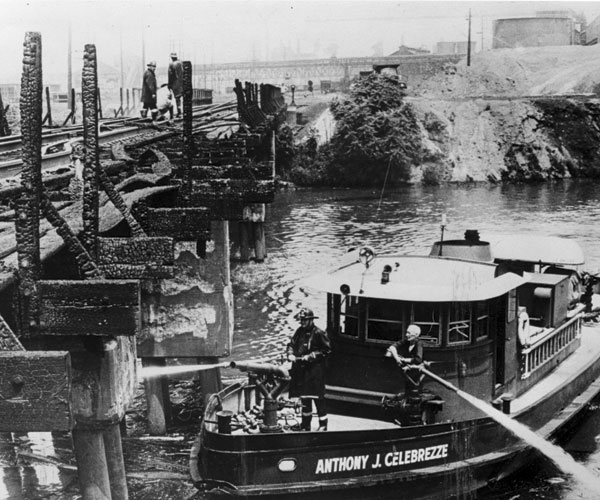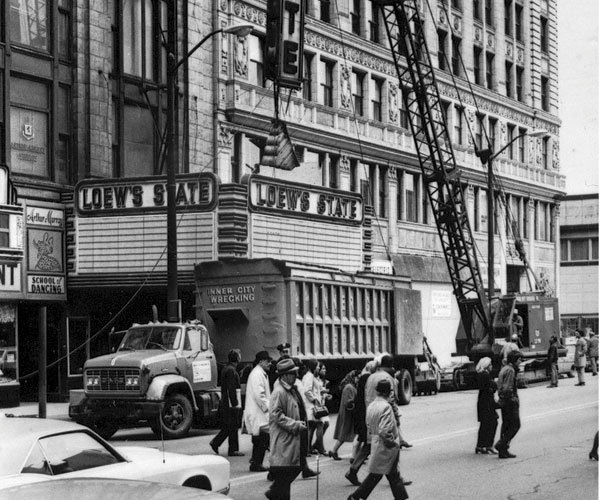Who Are We Now? Then & Now
by Madison Semarjian | Jul. 10, 2017 | 6:00 PM

The Clean Water Act of 1972
 Since the 1969 Cuyahoga River fire graced the pages of Time, Cleveland has been working to cleanse the oily stain on its reputation. Even when brothers Carl and Louis Stokes galvanized the country around the Clean Water Act of 1972, our relationship with the river has been tumultuous.
Since the 1969 Cuyahoga River fire graced the pages of Time, Cleveland has been working to cleanse the oily stain on its reputation. Even when brothers Carl and Louis Stokes galvanized the country around the Clean Water Act of 1972, our relationship with the river has been tumultuous.
“A lot of people from Cleveland didn’t want to talk about it,” says Bryan Stubbs, executive director at Cleveland Water Alliance. “Today, however, we look at the burning as a badge of pride, in terms of we’ve done a lot of work in restoring the Cuyahoga River.”
There have been economic results as well, with innovative companies such as ABS Materials, makers of materials able to remove a wide variety of contaminants from water, cropping up around water purification and wastewater management. “Water tech, as we call it, is expected to grow 10 to 12 percent annually,” he says. “This is the jobs of tomorrow.”
The Great Lakes region could also be the proving ground for out-of-this-world methods of water management. “We are now capable of monitoring water from space by satellite with NASA and can tell within a millimeter if a watershed is up or down,” explains Stubbs. “It helps us plan in terms of watershed management, agriculture and that food-water nexus.”
David Bowie Lands in the USA
 The vibe may have felt a little alien when David Bowie made his first U.S. stop Sept. 22, 1972, at Cleveland Music Hall just three months after the debut of his new album, The Rise and Fall of Ziggy Stardust and the Spiders from Mars. But even at that first up-close glimpse, the celestial-level talents of the orange-haired rocker sporting eyeliner and a British accent were obvious. “We reporters sensed that a star was born that night,” Plain Dealer critic Jane Scott recalled years later.
The vibe may have felt a little alien when David Bowie made his first U.S. stop Sept. 22, 1972, at Cleveland Music Hall just three months after the debut of his new album, The Rise and Fall of Ziggy Stardust and the Spiders from Mars. But even at that first up-close glimpse, the celestial-level talents of the orange-haired rocker sporting eyeliner and a British accent were obvious. “We reporters sensed that a star was born that night,” Plain Dealer critic Jane Scott recalled years later.
“Cleveland was known as a city that artists could break nationally and internationally,” says Jason Hanley, vice president of education and visitor engagement at the Rock and Roll Hall of Fame. “If you became popular in Cleveland, you could make it in many other markets across the United States.”
That’s certainly waned in the days since DJ Alan Freed coined the term rock ‘n’ roll. “There’s always going to be the ‘it’ city in music that people flock to often, like New York or LA or even Nashville,” explains Hanley, “but great live music is in the DNA of Cleveland.”
Recently, new record labels, such as Blue Arrow Records, and vinyl record maker, Gotta Groove Records, have sprouted from those roots.
“We are seeing a cottage industry of artists creating music here and staying here,” says Hanley. “Cleveland is going to become a hub for the industry side of the music business as well.”
Playhouse Square
 Say what you will about the massive, shimmering outdoor chandelier adorning Playhouse Square, but it may be the perfect symbol for the city’s theater district. Forty-five years ago, however, things looked bleak: The lights on the Ohio and State theaters were extinguished and a wrecking ball hung overhead. But Ray Shepardson, Lainie Hadden, and the Junior League of Cleveland raised money for renovations and saved the theaters from becoming parking lots.
Say what you will about the massive, shimmering outdoor chandelier adorning Playhouse Square, but it may be the perfect symbol for the city’s theater district. Forty-five years ago, however, things looked bleak: The lights on the Ohio and State theaters were extinguished and a wrecking ball hung overhead. But Ray Shepardson, Lainie Hadden, and the Junior League of Cleveland raised money for renovations and saved the theaters from becoming parking lots.
After investing more than $100 million to renovate and restore the five historic theaters since 1972, Playhouse Square now hosts more than 1,000 events each year, including expanded runs of its popular KeyBank Broadway Series. “All the major Broadway tours are tripping over themselves to come to Playhouse Square,” says Kevin Moore, managing director at Cleveland Play House, which moved to the district in 2011.
But the real proof is how Playhouse Square illuminates other parts of the arts community, Moore says. “We have a vibrant center,” he says, “but we are now in the neighborhood communities that will build into the future.” He points to theater and arts as marquee attractions for development in places such as Cleveland Heights, Gordon Square Arts District and Lakewood. That wouldn’t have been possible without Shepardson, Hadden and others. “Back then, the arts saved its own home because all these people believed in it,” explains Moore. “Hopefully, we can give back and be the shoulders upon which future theaters build their work.”
Trending
-
1
-
2
-
3
-
4
-
5










